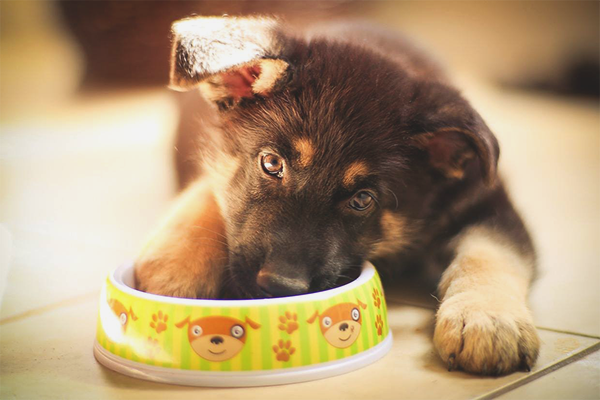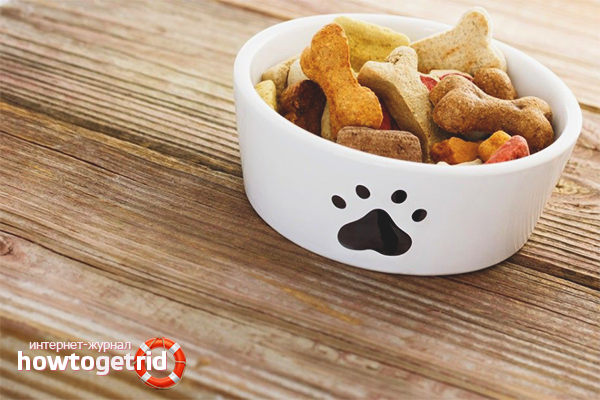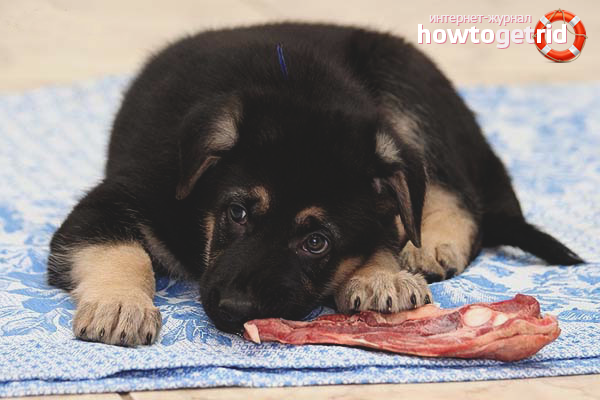The content of the article
Before talking about feeding, the owner of the puppy has to make a choice regarding the shape of the feed. Food can be cooked on its own, while the content will be several times cheaper than using purchased formulations. However, natural food takes time and attention to detail in order for a pet to grow up healthy and receive all the necessary microelements and vitamins. If we talk about ready-made feeds, the manufacturer took into account the age characteristics of puppies, included the necessary minerals, you just need to pour food into the bowl.
Practical recommendations for feeding puppies
- Always keep the dishes clean from which you feed your pet.
- Change the water every 3 hours in the summer and every 5 hours in the winter.
- After the meal, wipe your face puppy with a paper napkin or towel.
- In the first month of finding a puppy in a new place, be near him during meals.Watch the location of the pet, adjust the height of the bowl under its features.
- The food you feed the dog should not be too hot. The best option is room temperature. To check the mode correctly, lower the ring finger in the middle of the food bowl. If you are hot, leave the food to cool.
- Make a tight schedule of food, meals should be held strictly at the same time. Otherwise, the puppy will start having problems with sleep, lethargy will appear, growth will slow down.
- There are cases when a pet for no apparent reason refuses to eat. In such situations, remove the bowl from the puppy's field of view, offer him to eat in 30-40 minutes.
- Food for German Shepherd puppies should not be too dry or, on the contrary, liquid. Prepare food in such a way that it resembles sour cream in consistency.
- Experienced owners of German shepherds in one voice insist that feeding a puppy should be carried out after an intense walk. It makes sense to listen to them.
- To keep your pet's digestion, watch for its food hygiene. If possible, let the dog rest for 1.5-2 hours after the meal.
The right choice of dishes
- First of all, you need to take care of the pet bowl. It can be clay, metal, ceramic, plastic. The last option should be excluded, dishes of this kind fidget on the floor, not giving your pet the opportunity to eat normally.
- Small puppies often disperse the legs, especially for individuals living in an apartment. Arrange a feeding place based on flooring. If a laminate or linoleum is laid in the dwelling, spread a puppy under a bowl with a non-slip mat. It can be fabric or silicone.
- It is known that at the age of up to a year the puppy's skeleton is only being formed, as a result of which the skeleton is extremely fragile. For this reason, you need to put the bowl in such a way that it is located at the level of the pet's neck or chest. Otherwise, during the growth period, the puppy will constantly bend over, which will entail a curvature of the spine, high raised croup, weak bones of the front paws and chest, problems with swallowing and digestive activity. You can adjust the height of the tank with the help of special stands, which are sold in all pet stores.
Features diet puppies
Two-month puppies need to be fed 5-6 times a day with an interval of 3-4 hours. Pets who have reached 3-5 months, it is enough to feed 4 times a day. Starting from 6 months and up to a year the dog is fed 3 times a day. After this age, it is necessary to transfer the animal to two meals - in the morning and in the evening.
Age: 1 month
As a rule, puppies sell after 40-45 days after birth. During this period, the nutrition of the animal includes dairy products (in particular, yogurt, milk and cottage cheese), several types of meat, oatmeal and rice.
At this age, puppies have a rapid metabolism and a relatively small stomach. For this reason, the portions should be small (250 gr.), But substantial. As mentioned earlier, food should be taken every 3-4 hours.
Meat
Make sure that the puppy receives meat every day 2 times. It can be raw beef, cut into pieces, or chicken. Both products contain the optimal ratio of BZHU, due to which the pet will begin to grow before our eyes.
You can also give boiled meat, but it contains less enzymes than raw.Boiled beef or chicken is recommended to be given in cases when a puppy has a disorder in the stool or general malaise associated with digestion. To properly cook food based on boiled meat, cook oatmeal or rice porridge, cool it, crumble the meat. Dilute slightly with water, if the mixture is thick, check for temperature and give the puppy.
Important!
It is strictly not allowed to mix meat porridge with milk. The recommendation is relevant for the reason that after the assimilation of milk, casein is produced, which slows down the absorption of nutrients by the stomach. At the same time, the meat must be mixed with round-grain rice or oatmeal, but not with semolina.
Milk products
Cottage cheese must be given for breakfast, but not dry, otherwise the pet will choke. Mix 200 gr. product with kefir or yogurt, add a raw chicken egg. By and large, puppies refuse such food, but they need it. Therefore, teach your pet immediately, do not be fooled by tricks if he suddenly decides to refuse to eat.
You can cook cottage cheese with your own hands from kefir.The second option: mix ryazhenka with raw eggs and pour in boiling milk. Nobody will precisely refuse such delicacy, the dairy product turns out fragrant and tender.
Age: 2-3 months
Digestion of dogs at this age is already adapted to the fiber and protein without any consequences. It is time to add in the diet of natural oils and vegetables, so that in addition to cereal, cottage cheese and meat, the pet received other minerals. Portions should be 300-350 gr., The frequency of feeding - 4 times a day.
- Add a teaspoon of olive or sunflower oil to meat porridge 1 time per day. Periodically feed your puppy boiled carrots between main meals. It should be noted that chicken eggs should be given no more than 3 times a week. Cottage cheese, porridge, meat - unchanged.
- In the summer, focus on fresh fruits, many “Germans” have a passion for watermelons, melons, peaches and apples. Indulge your pet delicacies 2 times a day. Watch out for stools, with negative consequences, reduce fruit intake and give boiled chicken meat with rice porridge.
- At this age, the puppy can already be given large brain bones, so that he develops his jaw and grinds his teeth. If you keep a pet in the apartment, it is enough to pre-cook the bone. For animals that have access to the local area, it is better to choose the raw option.
Age: 4-5 months
From this period, the puppy needs to develop ligaments and joints. Also at this stage there is a change of teeth, so that the basis of the diet should be foods rich in calcium. The dog is still fed 4 times a day, observing a serving size of 300–400 grams.
- Changing teeth weakens cartilage tissue, so the ears of a pet may not rise. To contribute to full development, add collagen to food. It can be found in confectionery gelatin or local food additives (for dogs).
- At four months of age, puppies intensively develop a skeleton, in particular, posture. To help the body and lay the foundation for full development, gradually introduce chondoprotectors into the food. They are sold in the pet store, most importantly, clearly follow the instructions and do not increase the number arbitrarily.An alternative to the drug is "Artra", which can be purchased at a pharmacy.
- As for the main food, it remains the same (cottage cheese, meat, cereal, vegetables and fruits). However, now it is necessary to feed the puppy not the boiled meat, but the beef tenderloin from the head. Its composition contains a large amount of gelatin, which favorably affects the formation of the skeleton.
- You can cook the broth based on beef, veal, chicken, and then fill them with meat porridge. But do not make it too nourishing, so as not to burden the pancreas. Broth can be replaced with edible gelatin: dissolve it in water and mix in food (cottage cheese, porridge, a mixture of vegetables).
- Contribute to the rapid replacement of milk teeth by the molars, let us have a pet brain bones. Also it is necessary to focus on the calcined supplements marked “puppy”, a special series for German shepherd dogs is sold in pet stores. If you have difficulty with your choice, consult a veterinarian.
Age: 6–12 months
Once the puppy has reached the age of six months, it is possible to make porridge not only from pure meat, but also from offal (heart, liver, stomach).You can not give a dog thin bones, strong teeth, they easily gnaw, and the fragments will sink into the esophagus. Puppies for 6-12 months should have three meals a day, the serving size varies from 350 to 450 grams.
- At the same time every month you need to reduce the amount of cottage cheese eaten for breakfast, and at the same time increase the volume of meat. If you are the owner of the cable, completely remove the milk from the puppy's diet. In the case of bitches, the product is given daily.
- At this stage, the puppy owner needs to add active minerals, chondroprotectors, calcium and other vitamins, based on the weight and age of the pet. Do not forget about vegetables and fruits, feed them to your puppy between the main meals.
- To diversify the ration of cereals as much as possible, you can add buckwheat, millet, millet to the already existing rice and porridge. Combine them with each other, mix raw or cooked meat / offal. Break raw egg (sometimes chicken can be replaced with quail, double the amount).
- It is allowed to give the puppy sea or river fish 2 times a week. However, these days you can not feed the pet meat. Do not abuse the fish, because its composition destroys the vitamin B in the dog's body, which leads to difficulties with digestion and stunting.
The basis of feeding a puppy German shepherd is considered to be meat, cereals (except semolina), fresh or cooked vegetables, fruits. Do not forget to pamper your pet with brain bones, mix in nutritional supplements, gelatin, calcium. Choose the right bowl, adjust the height of the stand. Follow the schedule of meals, increase portions with age, walk more in the fresh air.
Video: German Shepherd Puppy Training






 4 votes, on average: 4,00 out of 5
4 votes, on average: 4,00 out of 5







To send